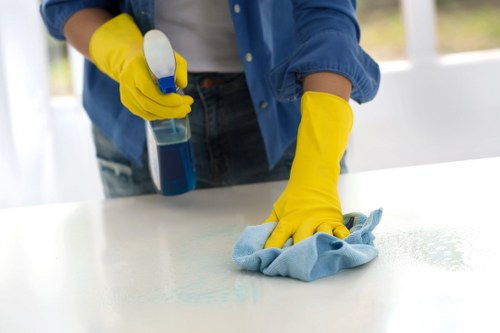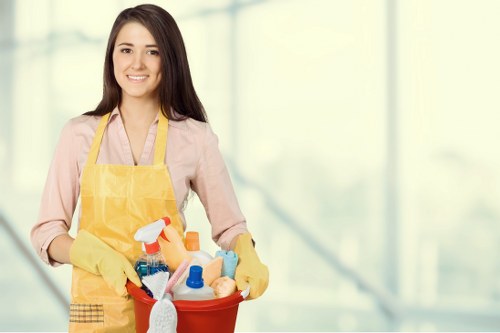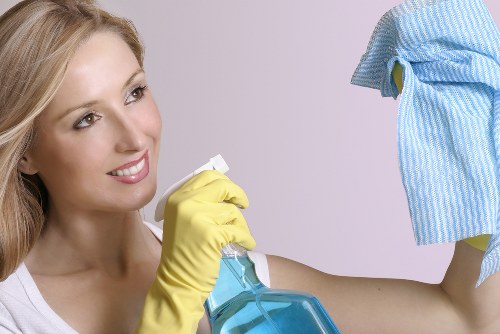Upholstery Cleaning in House Cleaners
Introduction to Upholstery Cleaning

Maintaining the cleanliness of your home’s upholstery is essential for both aesthetic appeal and the longevity of your furniture. Upholstery cleaning is a specialized process that removes dirt, stains, and allergens, ensuring a healthier living environment.
Regular cleaning not only enhances the appearance of your furniture but also preserves the fabric and materials, preventing wear and tear over time. Whether it's your sofa, chairs, or other upholstered items, professional cleaning services can make a significant difference.
Understanding the basics of upholstery cleaning can help you make informed decisions about the care and maintenance of your home furnishings.
Benefits of Professional Upholstery Cleaning

Professional upholstery cleaning offers numerous advantages over DIY methods. Trained technicians use specialized equipment and eco-friendly cleaning solutions to effectively remove stubborn stains and deeply embedded dirt.
Here are some key benefits:
- Thorough cleaning that reaches deep into the fabric
- Extended lifespan of your upholstery
- Improved indoor air quality by eliminating allergens
- Enhanced appearance and comfort of your furniture
- Time-saving and convenient service
Investing in professional services ensures that your upholstery receives the best care possible, maintaining its beauty and functionality for years to come.
Common Upholstery Cleaning Methods

There are several methods used in upholstery cleaning, each suited to different types of fabrics and levels of soiling. Understanding these methods can help you choose the right approach for your needs.
Steam Cleaning
Steam cleaning uses high-temperature steam to penetrate the fibers, effectively removing dirt and killing bacteria. This method is ideal for deep cleaning and is suitable for most fabrics.
Dry Cleaning
Dry cleaning employs chemical solvents instead of water, making it suitable for delicate fabrics that may be damaged by moisture. This method is quick and leaves little residue.
Shampoo Cleaning
Shampoo cleaning involves applying a foamy detergent to the fabric, agitating it to loosen dirt, and then extracting the residue. It is effective for heavily soiled upholstery but requires thorough drying to prevent mold growth.
Choosing the Right Upholstery Cleaner

Selecting a reputable upholstery cleaning service is crucial for achieving the best results. Here are some factors to consider:
- Experience and expertise in handling various fabrics
- Use of eco-friendly and safe cleaning products
- Positive customer reviews and testimonials
- Transparent pricing and detailed service offerings
- Availability of guarantees or warranties
By evaluating these aspects, you can find a trustworthy cleaner that meets your specific requirements and ensures the care your furniture deserves.
DIY Upholstery Cleaning Tips

While professional cleaning is recommended for the best results, there are some DIY upholstery cleaning techniques you can use to maintain your furniture between professional services.
Regular Vacuuming
Frequent vacuuming helps remove surface dirt and prevent it from settling deep into the fabric. Use the appropriate attachments to reach crevices and intricate patterns.
Spot Cleaning
Attend to spills and stains immediately by blotting them with a clean cloth. Avoid rubbing, as it can spread the stain and damage the fabric. Use a mild detergent solution for stubborn spots.
Protective Measures
Consider using fabric protectors to create a barrier against stains and spills. Additionally, rotating your furniture periodically can help distribute wear evenly.
Maintaining Upholstery Between Cleanings

Proper maintenance is key to extending the life of your upholstered furniture. Implementing a regular cleaning schedule and adopting preventive measures can keep your upholstery looking fresh and new.
Use of Throws and Covers
Utilize throws and covers to protect your furniture from everyday wear and accidental spills. These accessories are easy to wash and help maintain the original fabric in good condition.
Avoiding Direct Sunlight
Expose your upholstery to direct sunlight can cause fading and deterioration of fabrics. Position furniture away from windows or use curtains to shield against harsh sunlight.
Addressing Odors
Keep your upholstery smelling fresh by regularly airing out your furniture and using odor-neutralizing sprays. Avoid eating or drinking directly on upholstered surfaces to prevent lingering smells.
Environmental Benefits of Professional Cleaning

Opting for professional upholstery cleaning contributes to environmental sustainability. Many cleaners use eco-friendly products that minimize chemical usage and reduce pollution.
Eco-Friendly Cleaning Solutions
Professional services often utilize biodegradable and non-toxic cleaning agents that are safe for both the environment and your home. These solutions effectively remove dirt without harming natural ecosystems.
Water Conservation
Advanced cleaning techniques employed by professionals ensure efficient water usage, preventing excess waste and promoting conservation efforts.
Reduction of Carbon Footprint
By extending the lifespan of your furniture through proper maintenance, you reduce the need for frequent replacements, thereby decreasing your carbon footprint.
Cost-Effective Benefits of Regular Cleaning

Investing in regular upholstery cleaning can save you money in the long run by preserving your furniture and delaying the need for replacements or repairs.
- Prevents costly repairs due to fabric damage
- Maintains the value of high-end furniture
- Reduces the necessity for frequent replacements
- Enhances the overall appearance of your home, potentially increasing property value
Understanding the financial advantages of professional cleaning emphasizes the importance of incorporating it into your home maintenance routine.
Common Myths About Upholstery Cleaning

There are several misconceptions surrounding upholstery cleaning that can prevent people from seeking professional help. Let’s debunk some common myths:
Myth 1: Cleaning Upholstery is Expensive
Many believe that professional cleaning services are costly, but when you consider the long-term benefits and potential savings, it becomes a worthwhile investment.
Myth 2: DIY Cleaning is Just as Effective
While DIY methods can help with basic maintenance, they often lack the effectiveness and thoroughness of professional cleaning, which can reach deeper levels of dirt and stains.
Myth 3: Cleaning Damages the Fabric
Experienced professionals use appropriate techniques and products tailored to specific fabrics, ensuring that your upholstery is cleaned safely without causing damage.
Preparing for a Professional Upholstery Cleaning Service

To achieve the best results, proper preparation before a professional cleaning session is essential. This ensures a smooth and efficient process.
Remove Personal Items
Clear the area around the furniture by removing personal items, decorations, and anything that might obstruct access to the upholstery.
Inspect for Damage
Before cleaning, inspect your furniture for any existing damage. Inform the cleaning service of any issues so they can handle the process with care.
Communicate Special Requirements
Let the cleaners know about any specific concerns or preferences you have regarding the cleaning process, such as sensitivity to certain chemicals or stains you want to highlight.
The Cleaning Process Explained

Understanding the steps involved in professional upholstery cleaning can give you confidence in the process and what to expect.
Assessment and Inspection
The cleaning team begins with a thorough assessment of your upholstery to identify fabric types, existing stains, and the level of soiling. This helps in determining the most effective cleaning method.
Pre-Treatment
Stains and high-traffic areas receive special attention through pre-treatment with appropriate solutions to break down dirt and stains, making them easier to remove during the cleaning process.
Cleaning
The main cleaning phase involves applying the chosen method, whether it’s steam, dry, or shampoo cleaning, to thoroughly clean the fabric and remove embedded dirt.
Drying and Finishing
After cleaning, the upholstery is carefully dried using specialized equipment to prevent mold and mildew. Once dry, any remaining finishings are applied to nourish the fabric and restore its original luster.
Choosing the Right Cleaning Products

The selection of cleaning products plays a critical role in the effectiveness and safety of the upholstery cleaning process.
Eco-Friendly Options
Opt for cleaners that are biodegradable and free from harsh chemicals to protect both your health and the environment. These products are effective in removing dirt while being gentle on fabrics.
Fabric-Specific Cleaners
Different fabrics require different cleaning agents. Professional cleaners have access to a variety of specialized products that cater to specific upholstery materials, ensuring optimal results without causing damage.
Non-Toxic Solutions
Non-toxic cleaners are especially important in households with children or pets, as they minimize the risk of harmful residues and odors.
Addressing Stubborn Stains

Some stains can be particularly challenging to remove. Professional upholstery cleaners are equipped with advanced techniques and solutions to tackle even the most stubborn blemishes.
Pet Stains and Odors
Pet-related stains and odors require specialized treatments that neutralize the source and eliminate lingering smells, ensuring a fresh and clean environment.
Wine and Coffee Spills
Beverage spills like wine and coffee can leave lasting stains if not addressed promptly. Professional cleaners use targeted methods to break down and remove these types of stains effectively.
Ink and Grease Stains
Ink and grease are particularly persistent and necessitate the use of strong yet safe cleaning agents to dissolve and lift the stains without damaging the fabric.
Post-Cleaning Care Tips

After your upholstery has been professionally cleaned, adopting certain care practices can help maintain its fresh appearance and prolong its lifespan.
Regular Maintenance
Implement a routine of regular vacuuming and spot cleaning to keep your upholstery in top condition between professional cleanings.
Immediate Spill Response
Attend to spills and accidents immediately to prevent stains from setting in. Blot gently and use appropriate cleaning agents as needed.
Avoid Excessive Sunlight
Protect your upholstery from prolonged exposure to sunlight by using curtains or repositioning furniture to prevent fading and fabric degradation.
Conclusion

Upholstery cleaning is a vital aspect of maintaining a clean and healthy home. Whether you choose professional cleaning services or adopt DIY methods, regular attention to your upholstered furniture can enhance its appearance, extend its lifespan, and contribute to a more comfortable living space.
Don’t wait until stains become irreparable—contact us today to book your upholstery cleaning service and experience the difference professional care can make!

